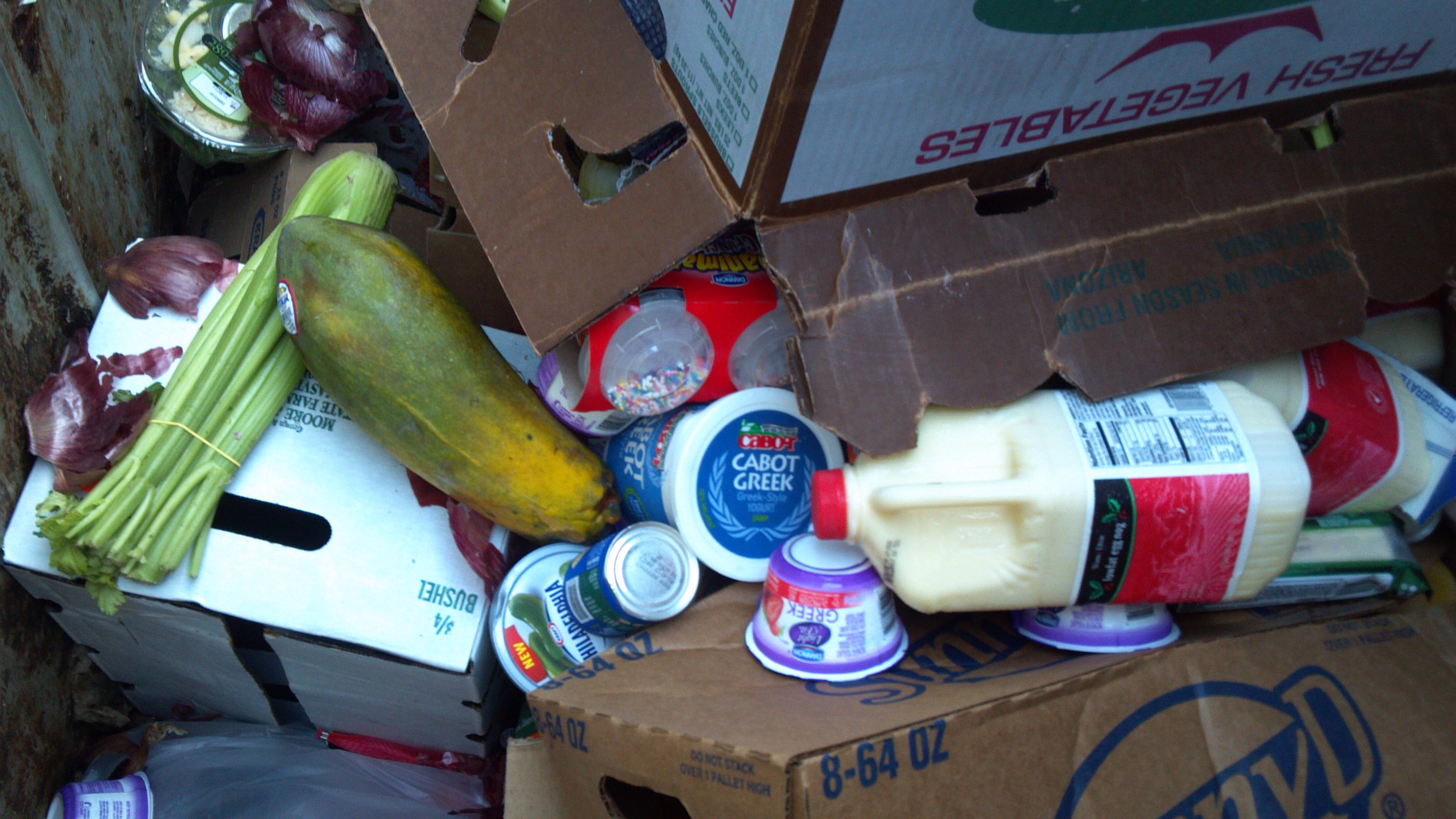 By Matt Keene | gargoyle@flagler.edu
By Matt Keene | gargoyle@flagler.edu
It is sometime past sunset. The world is dark and the noise of traffic has settled down for the night.
I am standing in a dumpster with a smile stretched across my face, visualizing homemade apple cider, massive green salads bursting with fireworks of peppers and tomatoes, and a special treat to add to a smoothie: blueberries.
I reach down and pull up the 3-pound bags of McIntosh and Gala apples. A couple soft spots inside, on a single apple… that’s all. I rummage through the boxes of discarded leaf lettuces, just barely wilted. A bowl of cold water and some ice cubes will crisp those leaves right up… There are more vegetables here than I could force myself to eat. I pick out the best of the peppers and tomatoes, avoiding the ones that have gone bad. I grab a few zuchinis and a squash for later. Tonight’s been a good night. Lastly, I lift up two quart-sized containers of blueberries, dripping with antioxidants.
I pull myself up and out of the dumpster, my shoes smacking the pavement and echoing out into the night.
According to the USDA, an estimated 133 billion pounds of food went uneaten from retail food stores, restaurants and homes in 2010 alone. Most of that food found its way into landfills, the third largest producer of greenhouse-causing methane gas in the United States. The Environmental Protection Agency states that, in 2011, more than 36 million tons of food waste was generated — totaling 21 percent, and the largest percentage of waste, going into municipal landfills.
In St Augustine, enough food goes to waste that I am able to feed my family nutritional, healthy meals every single day, every single meal, straight from the dumpster. In fact, I eat better outside, getting my food out of the dumpster, than I ever did making a grocery list and wandering through the aisles inside. According to a report by the Natural Resources Defense Council, more fruits and vegetables go to waste (52 percent) than get consumed (48 percent), meaning I have a constant, steady supply of fruits and vegetables waiting in the dumpster. In other words, it’s more likely there will be fruits and vegetables in the dumpster than unlikely.

Food is special. Numerous recent studies have linked mental health to diet; a study published in PlosOne in 2011 found that “adolescents who improved the quality of their diets also experienced improved mental health. In contrast, those whose dietary quality deteriorated experience a worsening of their mental health status.” And yet, it’s hard to see the value in food when you walk past aisles and aisles of it. The overwhelming volume of boxed, canned and processed items strip food of its value. Grocery shopping becomes a chore. Cooking meals becomes a duty. There is more than one reason that local farmer’s markets, community gardens, heirloom fruits and vegetables and seasonal foods have gained in popularity. Meeting your food in this way creates a connection. It adds value that is lost in the industrial, consumerist agricultural system.
When you see the farmer at the market standing behind his produce, you see the whole process. You see the value the farmer placed in the seed. You see the care the farmer took in watering, weeding and waiting. You see the beauty in the finished product and you want to make a meal. You want to enjoy that food and make something special that reflects the value you have seen in the product.
The NRDC states that “getting food to our tables eats up 10 percent of the total U.S. Energy budget, uses 50 percent of U.S. Land, and swallows 80 percent of freshwater consumed in the United States. Yet 40 percent of food in the United States today goes uneaten. That is more than 20 pounds of food per person every month.”
This excessive waste contributes to greenhouse gases, energy loss, water, chemical and fertilizer waste, and devalues every single meal we eat. In spite of this waste, according to the Economic Research Service of the USDA, 17.6 million households were food insecure in 2012. A reduction in our food waste by just 15 percent would be more than enough to feed these food-insecure homes, including the 10 percent of homes where children struggle with hunger.
The food that I dumpster will be washed, prepared and stored.
My freezer is bursting with fresh-baked bakery breads and frozen fruits waiting for smoothies. My fridge is full of dumpstered vegetables and lettuces, yogurts, cheese, milk and juice. The smell of homemade apple cider lingers in the air from two 3-pound bags of apples. My pantry is stacked with dented cans and packaged snacks just past their expiration date.
My total grocery bill for the month of November was zero dollars.
I wish I could recover all of the food I see in dumpsters. I wish I could find a home for all of it. But, it stacks up. Every day it stacks up. Until the Division of Solid Waste comes by in their large, dark trucks. Until they take the food away, far away from those who need it, far away from the questioning eyes and bewildered looks. Far away, to rot in a pile of refuse, to provide one final, sincere acknowledgement that food has no value in this land and that hunger can not cry loud enough.
[divide]
On Monday, Dec. 2, the U.S. Green Building Council North Florida Chapter will be screening “Dive! The Film” about food waste, dumpster diving and change. Matt Keene will be a panelist answering questions about dumpster diving and the value of food following the screening. More information about the event can be found on USGBC North Florida’s Facebook event page.




Be the first to comment on "Why I dive: Reclaiming food’s value and joy"